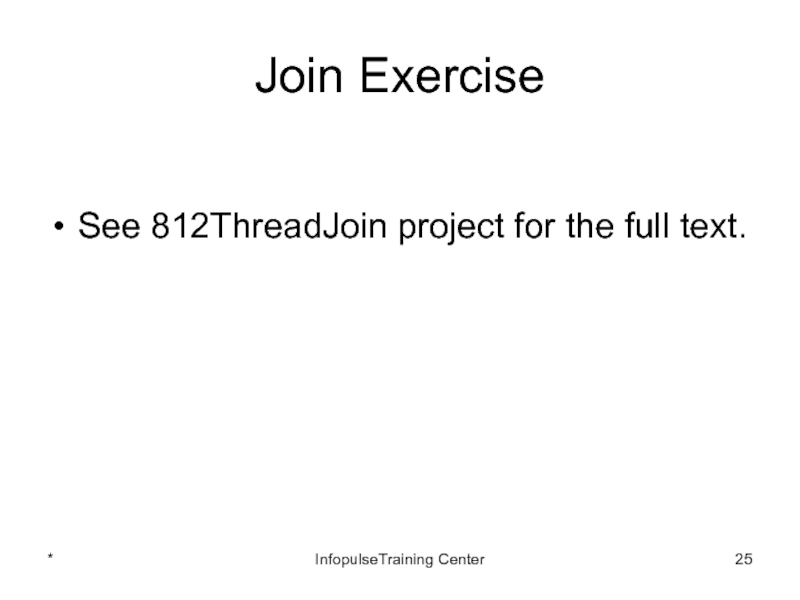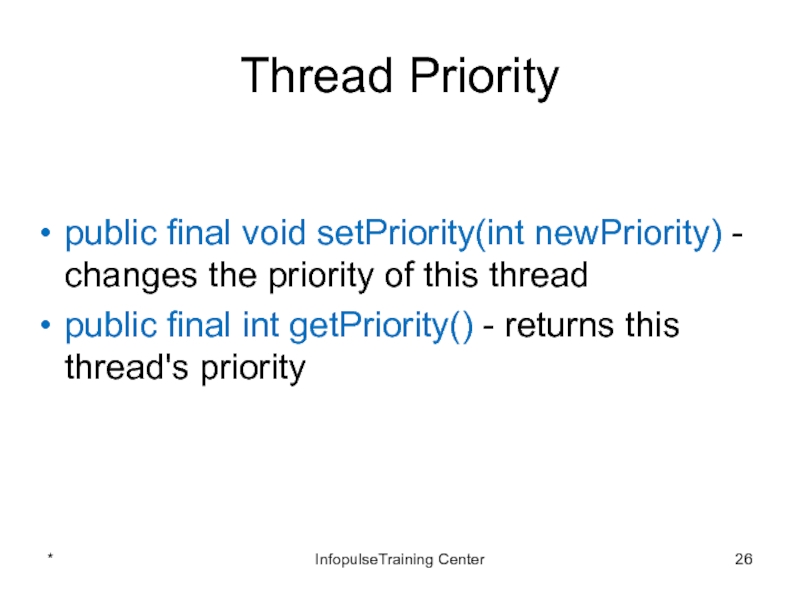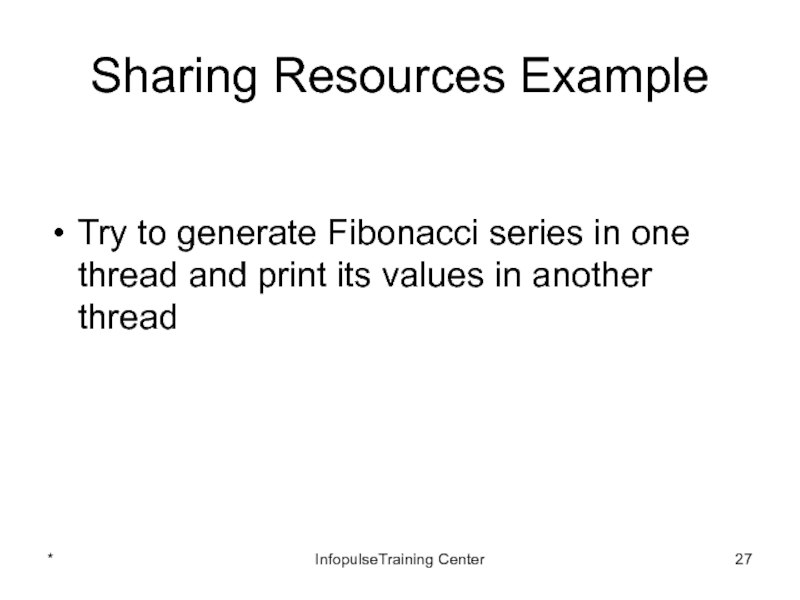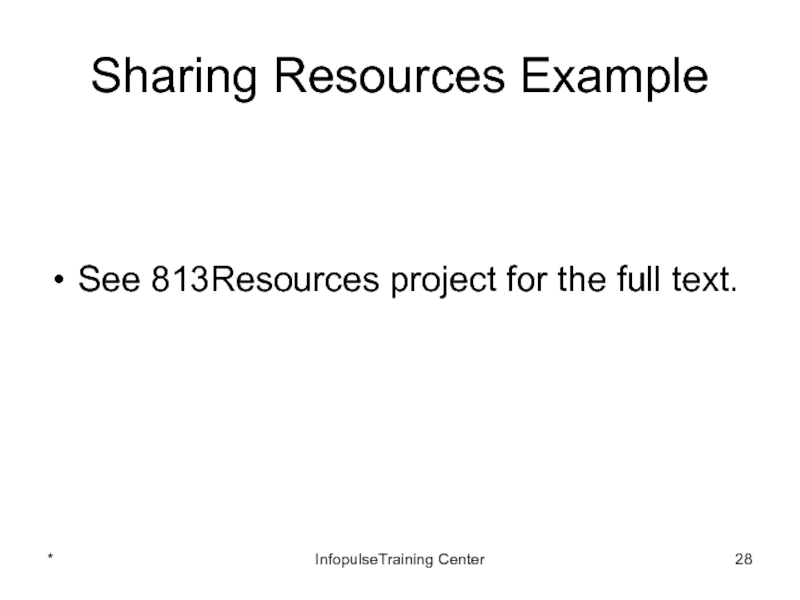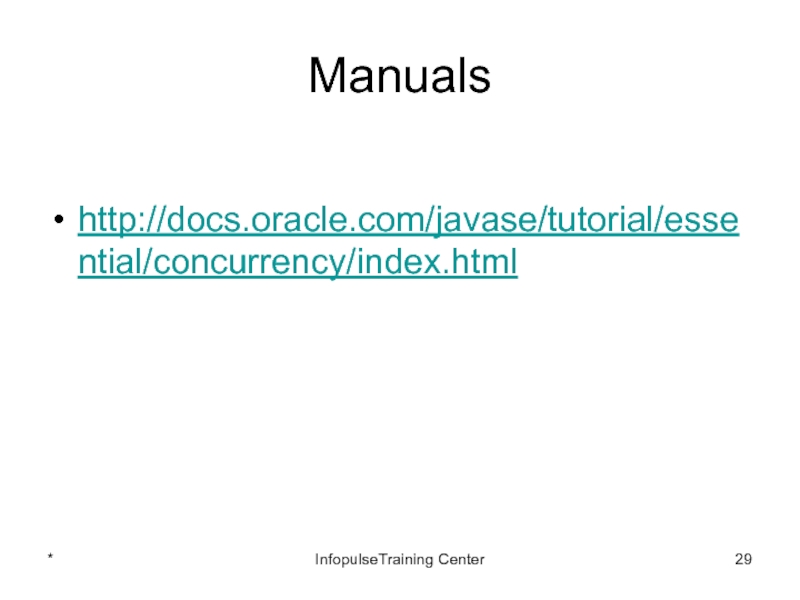- Главная
- Разное
- Дизайн
- Бизнес и предпринимательство
- Аналитика
- Образование
- Развлечения
- Красота и здоровье
- Финансы
- Государство
- Путешествия
- Спорт
- Недвижимость
- Армия
- Графика
- Культурология
- Еда и кулинария
- Лингвистика
- Английский язык
- Астрономия
- Алгебра
- Биология
- География
- Детские презентации
- Информатика
- История
- Литература
- Маркетинг
- Математика
- Медицина
- Менеджмент
- Музыка
- МХК
- Немецкий язык
- ОБЖ
- Обществознание
- Окружающий мир
- Педагогика
- Русский язык
- Технология
- Физика
- Философия
- Химия
- Шаблоны, картинки для презентаций
- Экология
- Экономика
- Юриспруденция
8. Java concurrency 1. Threads презентация
Содержание
- 1. 8. Java concurrency 1. Threads
- 2. Concurrency A single application is often expected
- 3. Processes A process has a self-contained execution
- 4. Threads I Threads are sometimes called lightweight
- 5. Threads II Threads share the process's resources,
- 6. Defining a Thread An application that creates
- 7. Runnable Object The Runnable interface defines a
- 8. Runnable Object Example public class HelloRunnable implements
- 9. Runnable Object in Java 8 public static
- 10. Thread Subclass The Thread class itself implements
- 11. Thread Subclass Example public class HelloThread extends
- 12. Runnable vs Thread Subclass A Runnable object
- 13. Pausing Execution with Sleep Thread.sleep causes the
- 14. Sleep Example public class SleepMessages {
- 15. Thread Race Example Create two classes: first
- 16. Thread Race Example See 811ThreadRace project for the full text. * InfopulseTraining Center
- 17. Thread Terminations A thread terminates when: its
- 18. Interrupted Status When the interrupt method is
- 19. How to Check Interrupted Status To find
- 20. InterruptedException If a thread is blocked, it
- 21. InterruptedException Example for (int i =
- 22. Joins The join method allows one thread
- 23. Join Exercise Modify 811ThreadRace project so that
- 24. ThreadRace Class public static void main(String[] args)
- 25. Join Exercise See 812ThreadJoin project for the full text. * InfopulseTraining Center
- 26. Thread Priority public final void setPriority(int newPriority) - changes the
- 27. Sharing Resources Example Try to generate Fibonacci
- 28. Sharing Resources Example See 813Resources project for the full text. * InfopulseTraining Center
- 29. Manuals http://docs.oracle.com/javase/tutorial/essential/concurrency/index.html * InfopulseTraining Center
Слайд 2Concurrency
A single application is often expected to do more than one
Software that can do such things is known as concurrent software
Since version 5.0, the Java platform has also included high-level concurrency APIs
*
InfopulseTraining Center
Слайд 3Processes
A process has a self-contained execution environment
A process generally has a
A Java application can create additional processes using a ProcessBuilder object.
Multiprocess applications are beyond the scope of this lesson
*
InfopulseTraining Center
Слайд 4Threads I
Threads are sometimes called lightweight processes
Both processes and threads provide
Threads exist within a process — every process has at least one thread
*
InfopulseTraining Center
Слайд 5Threads II
Threads share the process's resources, including memory and open files
From
This thread has the ability to create additional threads
*
InfopulseTraining Center
Слайд 6Defining a Thread
An application that creates an instance of Thread must
Provide a Runnable object.
Create Thread Subclass.
*
InfopulseTraining Center
Слайд 7Runnable Object
The Runnable interface defines a single method, run, meant to
The Runnable object is passed to the Thread constructor
Thread’s start method is called
*
InfopulseTraining Center
Слайд 8Runnable Object Example
public class HelloRunnable implements Runnable {
public void
System.out.println("Hello from a thread!");
}
public static void main(String args[]) {
(new Thread(new HelloRunnable())).start();
}
}
*
InfopulseTraining Center
Слайд 9Runnable Object in Java 8
public static void main(String args[]) {
Runnable
() -> System.out.println("Hello world!");
new Thread(r).start();
}
Слайд 10Thread Subclass
The Thread class itself implements Runnable, though its run method
An application can subclass Thread, providing its own implementation of run
*
InfopulseTraining Center
Слайд 11Thread Subclass Example
public class HelloThread extends Thread {
public void
}
public static void main(String args[]) { (new HelloThread()).start();
}
}
*
InfopulseTraining Center
Слайд 12Runnable vs Thread Subclass
A Runnable object employment is more general, because
Thread subclassing is easier to use in simple applications, but is limited by the fact that your task class must be a descendant of Thread
A Runnable object is applicable to the high-level thread management APIs
*
InfopulseTraining Center
Слайд 13Pausing Execution with Sleep
Thread.sleep causes the current thread to suspend execution
This is an efficient means of making processor time available to the other threads of an application or other applications that might be running on a computer system
The sleep period can be terminated by interrupts
*
InfopulseTraining Center
Слайд 14Sleep Example
public class SleepMessages {
public static void main(String args[])
String importantInfo[] = { "Mares eat oats",
"Does eat oats", "Little lambs eat ivy",
"A kid will eat ivy too"};
for (int i = 0; i < importantInfo.length; i++) {
Thread.sleep(4000);
System.out.println(importantInfo[i]);
}
}
}
*
InfopulseTraining Center
Слайд 15Thread Race Example
Create two classes: first implements Runnable interface, and second
*
InfopulseTraining Center
Слайд 17Thread Terminations
A thread terminates when:
its run method returns, by executing a
after executing the last statement in the method body
if an exception occurs that is not caught in the method
The interrupt method can be used to request termination of a thread
*
InfopulseTraining Center
Слайд 18Interrupted Status
When the interrupt method is called on a thread, the
This is a boolean flag that is present in every thread
Each thread should occasionally check whether it has been interrupted
*
InfopulseTraining Center
Слайд 19How to Check Interrupted Status
To find out whether the interrupted status
while (!Thread.currentThread().isInterrupted())
{
do more work
}
*
InfopulseTraining Center
Слайд 20InterruptedException
If a thread is blocked, it cannot check the interrupted status
This
When the interrupt method is called on a thread that blocks on a call such as sleep or wait, the blocking call is terminated by an InterruptedException
*
InfopulseTraining Center
Слайд 21 InterruptedException Example
for (int i = 0; i < importantInfo.length; i++)
// Pause for 4 seconds
try { Thread.sleep(4000); }
catch (InterruptedException e) {
return;
}
System.out.println(importantInfo[i]);
}
*
InfopulseTraining Center
Слайд 22Joins
The join method allows one thread to wait for the completion
If t is a Thread object whose thread is currently executing, t.join() causes the current thread to pause execution until t's thread terminates
Overloads of join allow the programmer to specify a waiting period
join responds to an interrupt by exiting with an InterruptedException
*
InfopulseTraining Center
Слайд 23Join Exercise
Modify 811ThreadRace project so that first thread should wait for
*
InfopulseTraining Center
Слайд 24ThreadRace Class
public static void main(String[] args) throws InterruptedException{
ThreadRunnab r = new
Thread t1 = new Thread(r);
Thread t2 = new ThreadThread();
r.setThread(t2);
t1.start();
t2.start();
}
*
InfopulseTraining Center
Слайд 26Thread Priority
public final void setPriority(int newPriority) - changes the priority of this thread
public final int getPriority()
*
InfopulseTraining Center
Слайд 27Sharing Resources Example
Try to generate Fibonacci series in one thread and
*
InfopulseTraining Center
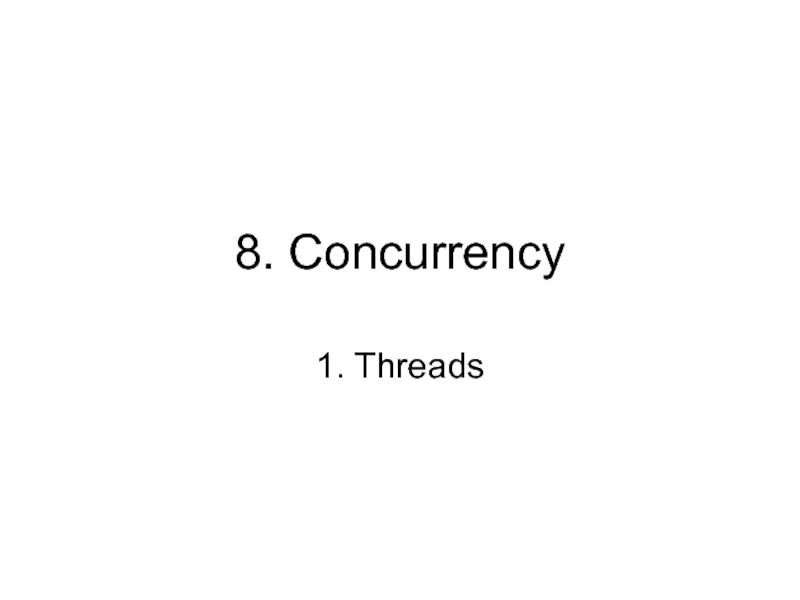
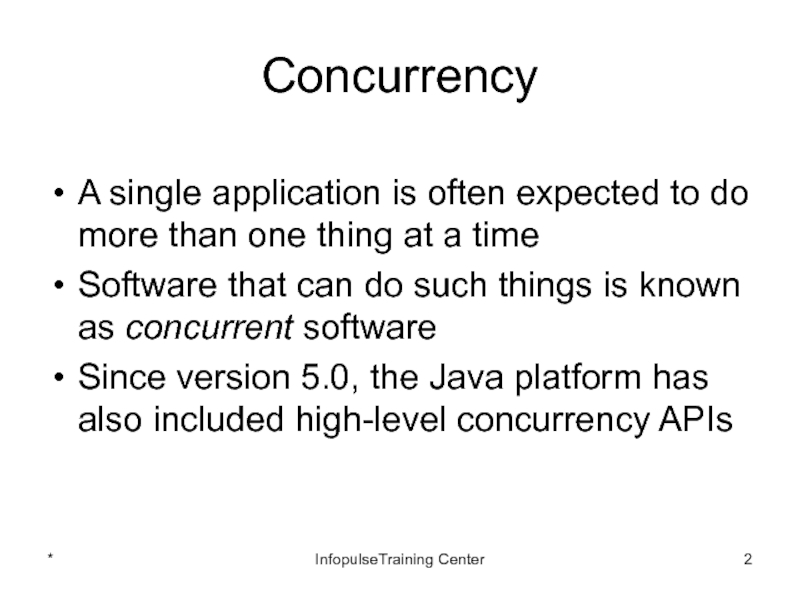
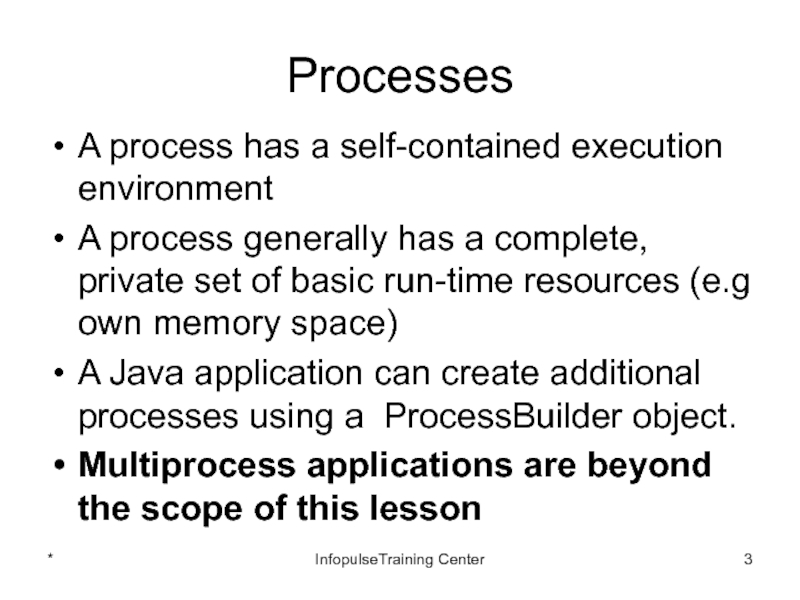
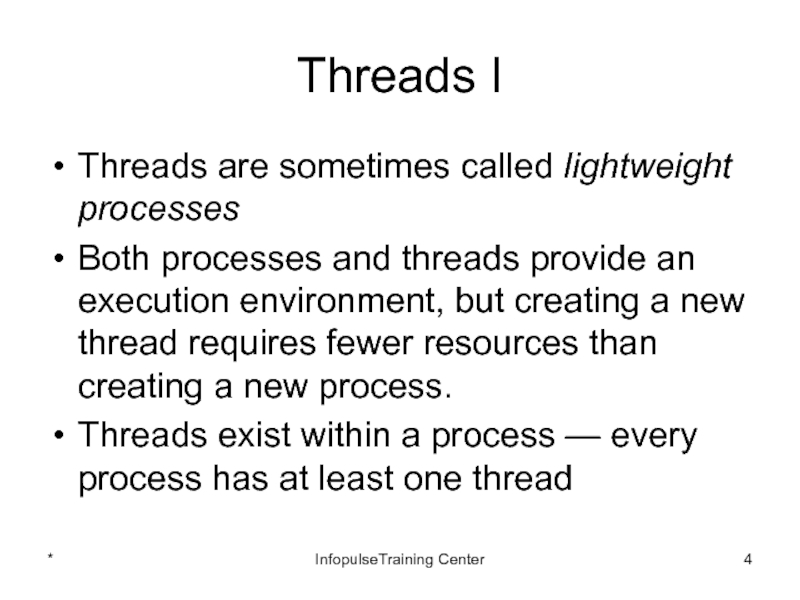
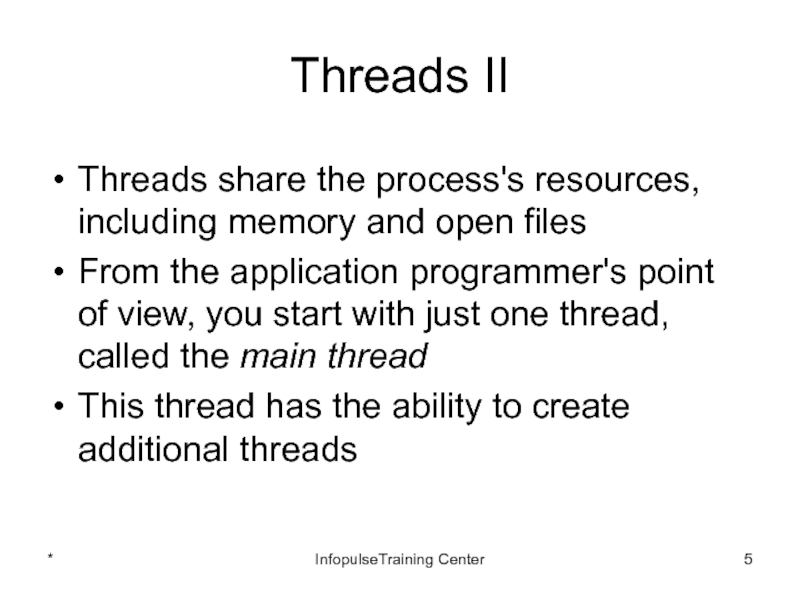
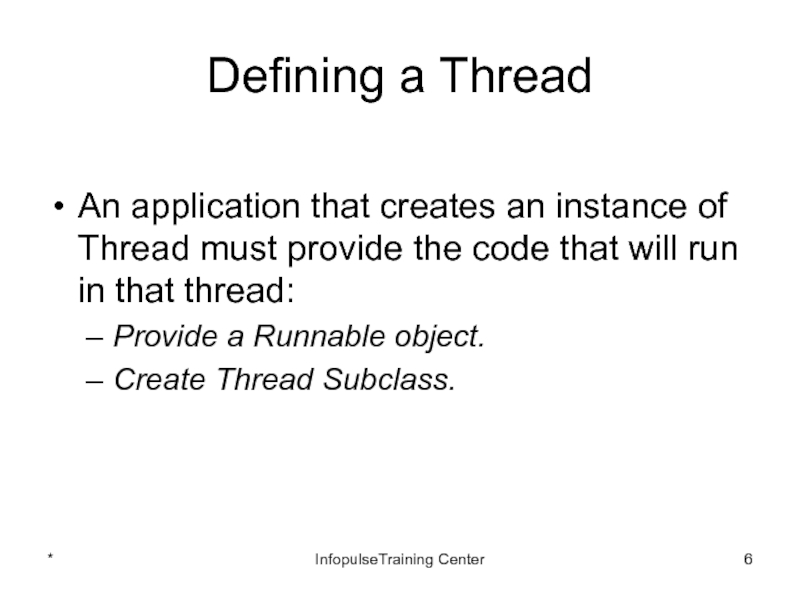
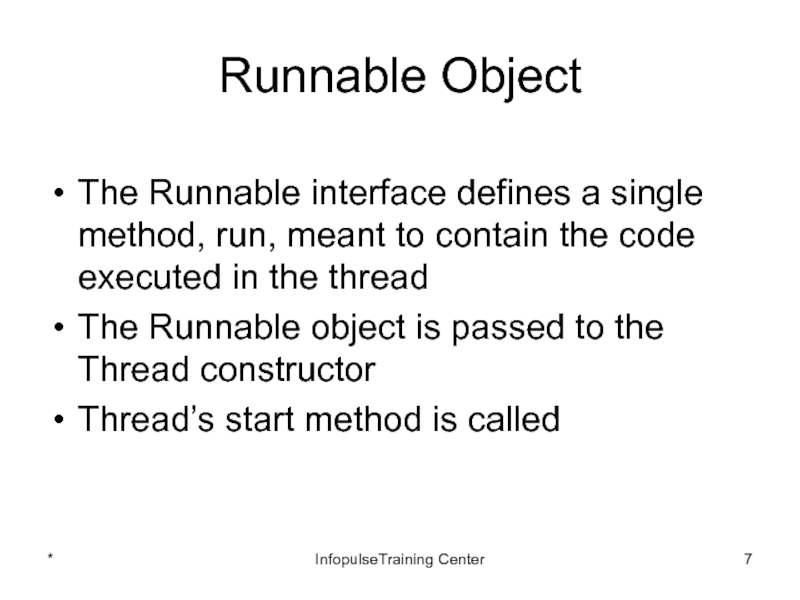
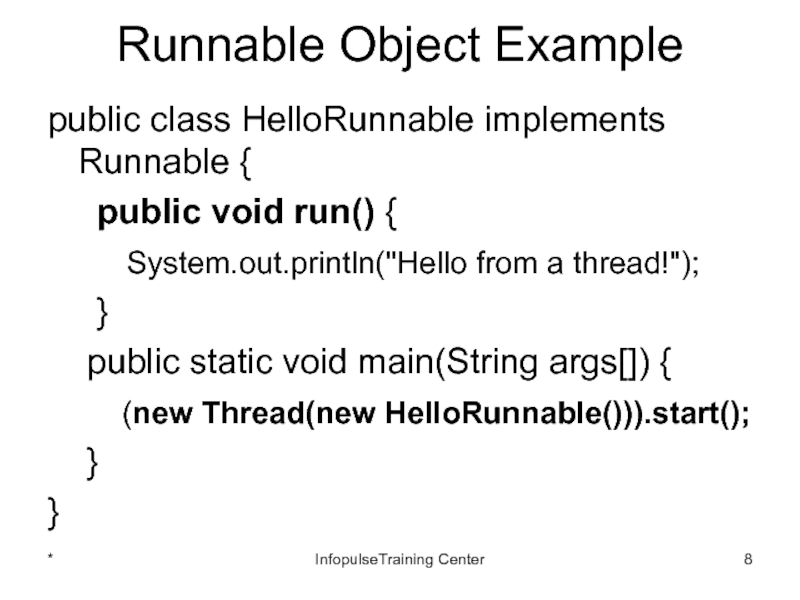
![Runnable Object in Java 8public static void main(String args[]) { Runnable r = () ->](/img/tmb/5/442506/d36871cdabda18ebf5798eca67ee2072-800x.jpg)
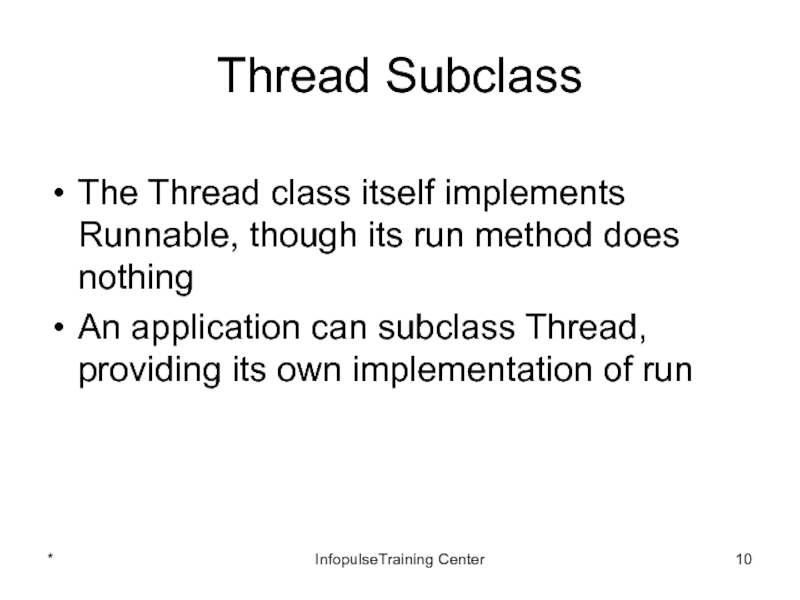
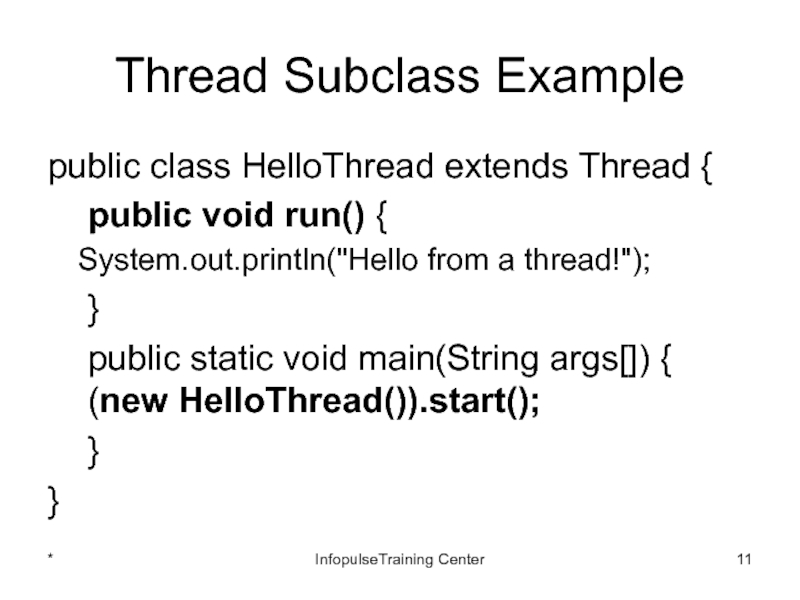
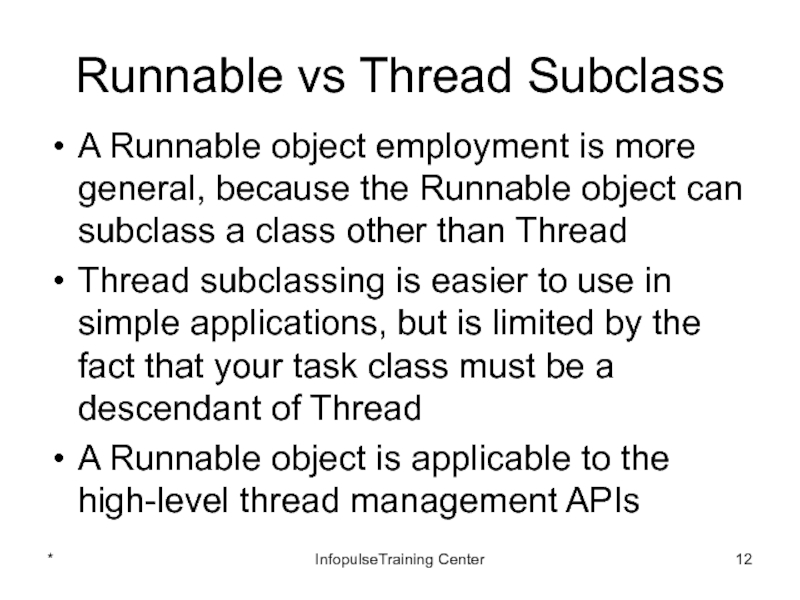
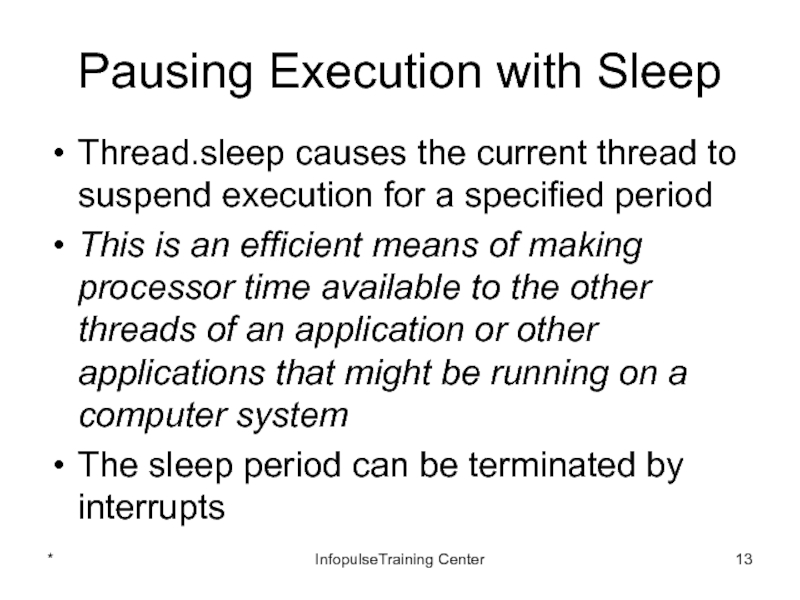
![Sleep Examplepublic class SleepMessages { public static void main(String args[]) throws InterruptedException { String](/img/tmb/5/442506/2dd5e79a81ce005e47be2532517cdf30-800x.jpg)
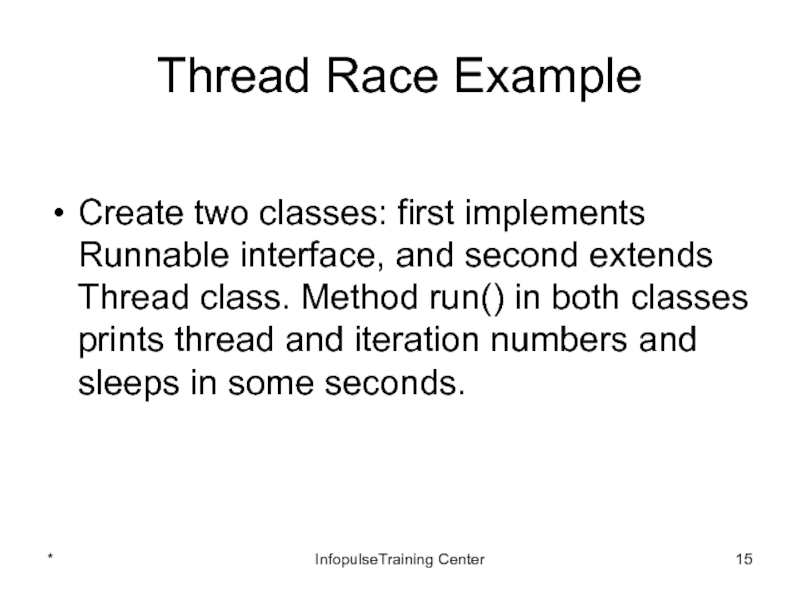
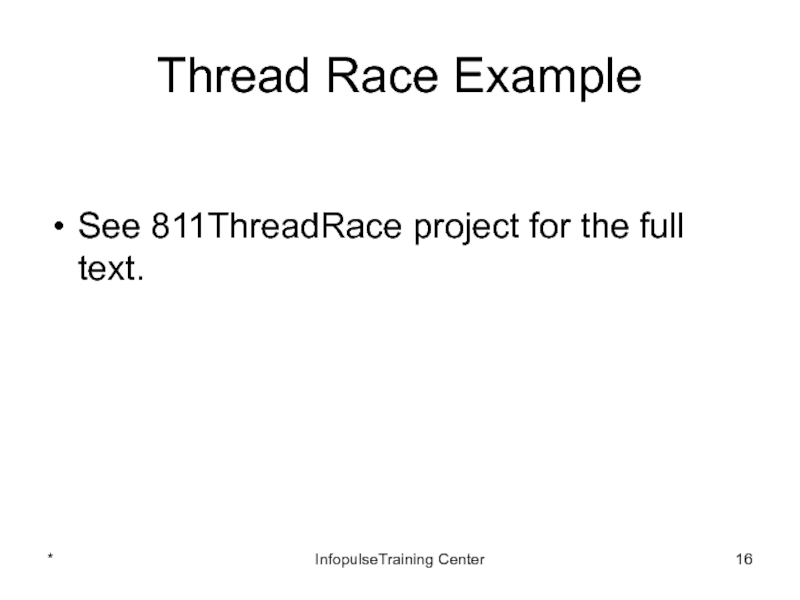
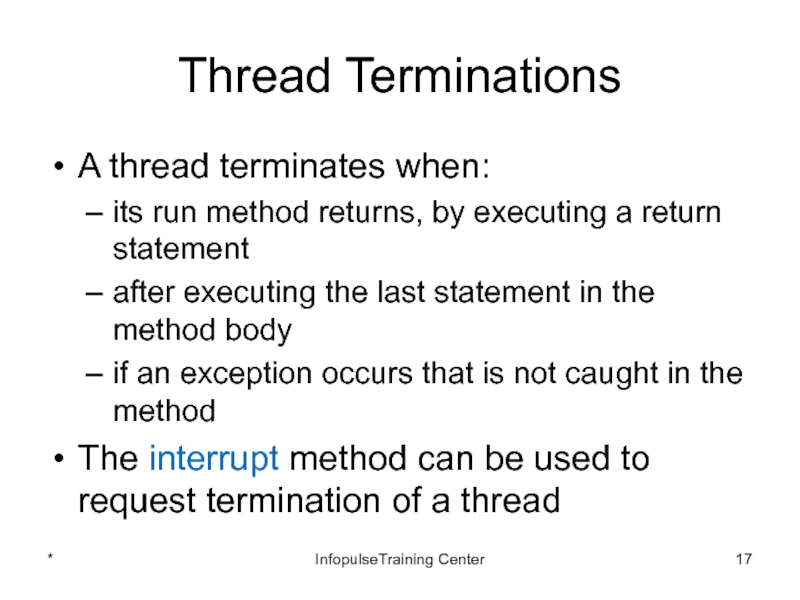
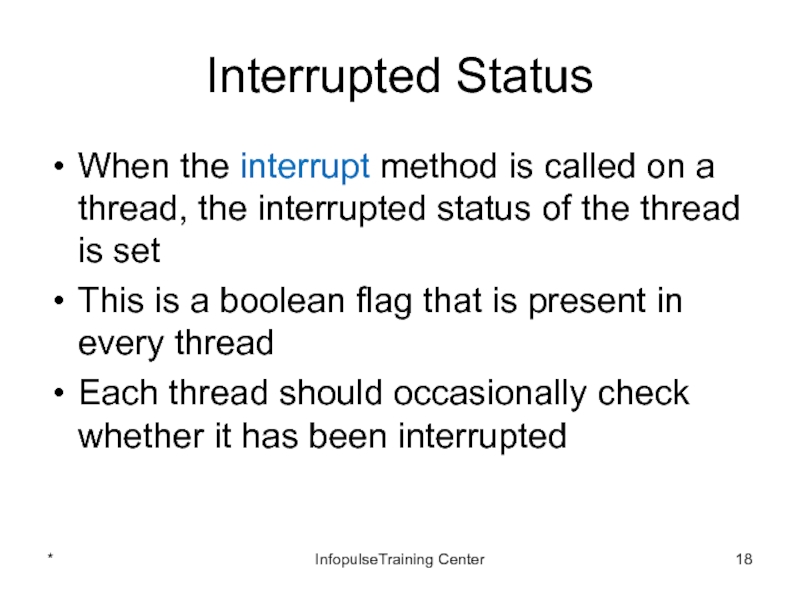
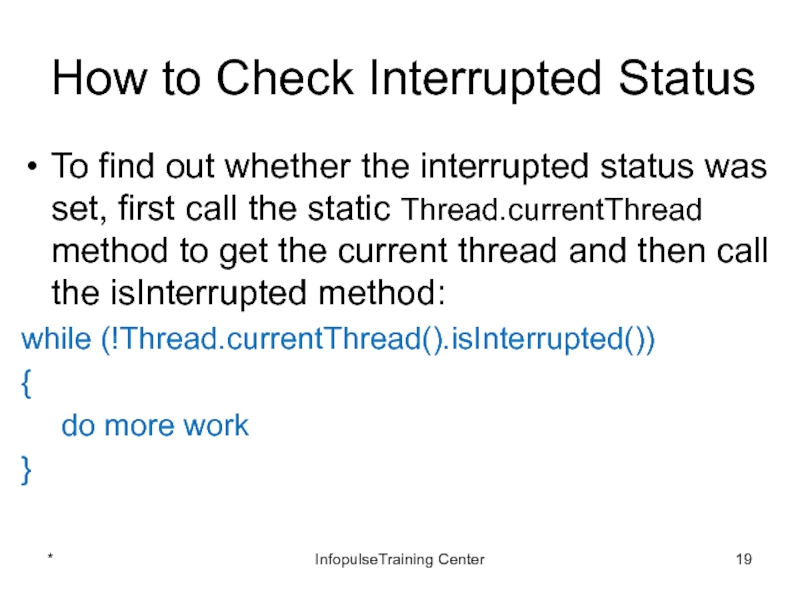
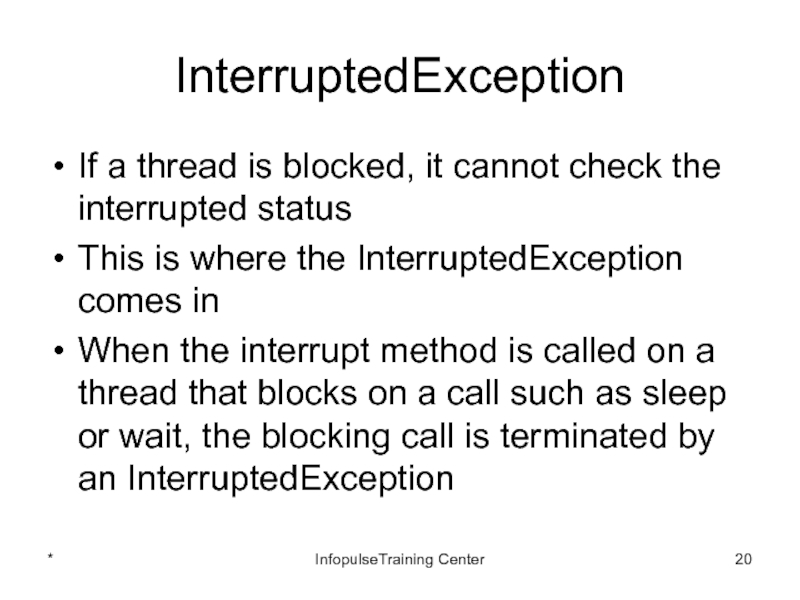
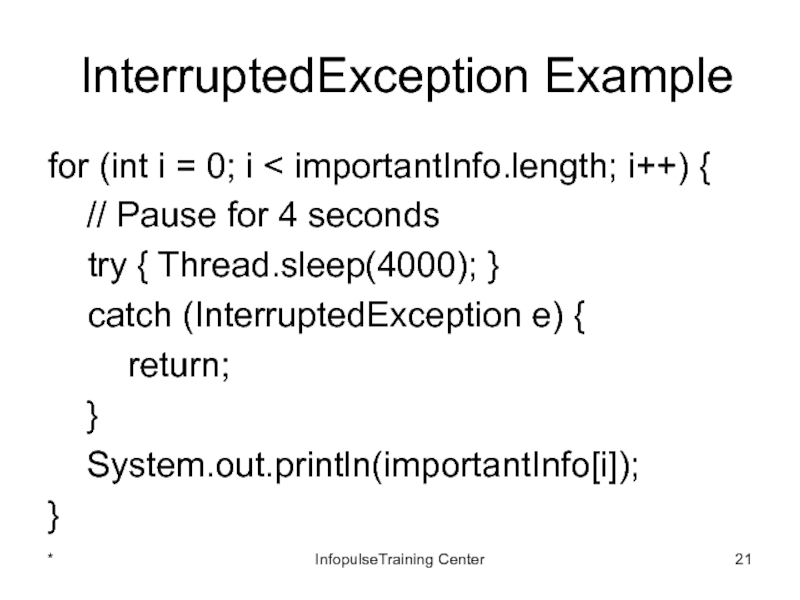
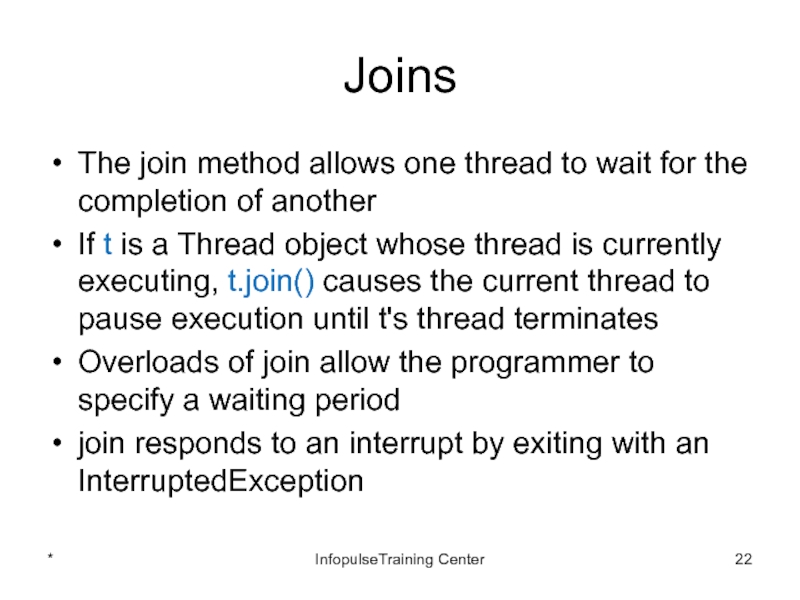
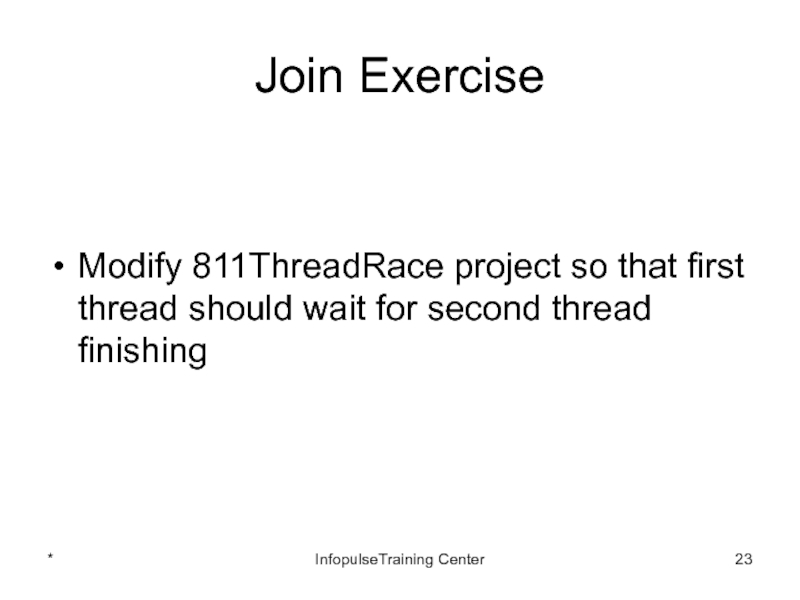
![ThreadRace Classpublic static void main(String[] args) throws InterruptedException{ ThreadRunnab r = new ThreadRunnab(); Thread t1 = new](/img/tmb/5/442506/7626577f6566406a3afbafdd492fbf23-800x.jpg)
